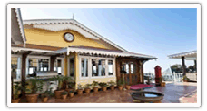|
|
|
| |
Travel destination in India, Mumbai |
|
[ Book Hotels in Mumbai] |
[ other Travel Destinations in India ] |
Travel destination in India, MUMBAI |
Mumbai is the capital of Maharashtra and the economic powerhouse India. It's an exhilarating city, fuelled by entrepreneurial energy, determination and dreams. Compared to the torpor of the rest of India, it can seem like a foreign country. Mumbai is the finance capital of the nation, the industrial hub of everything from textiles to petrochemicals, and it's responsible for half the country's foreign trade. To many visitors, Mumbai is the glamour of Bollywood cinema, cricket on the maidans on weekends, bhelpuri on the beach at Chowpatty and red double-decker buses. While it boasts an impressive Victoria townscape, a sculptured island cave temple and a national park that's roamed by wild tigers, the city's formal attractions pale in comparison to the nonstop theater of its streets. Sixteen million people from all over India are wedged into Mumbai and after a short stroll you will feel like you have rubbed shoulders with and bumped into every single one of them. The size of the population means the city has enough social problems to last a lifetime, but its spirit is irrepressible and it has personality by the bucket load. As the cultural bridgehead between east and west, whatever happens in the rest of India tends to happens first in Mumbai, and it usually happens with the maximum amount of swank and noise. Most visitors to India gear themselves up to confront poverty, but it's the extravagant display of wealth in Mumbai that seem shocking. In many parts of the city flash cars and mobile phones are as common as street kids or beggars, and Mumbai loves to claim it has more millionaires than Manhattan. Flush with money, the city has an established social elite and an entertainment hungry middle class, which mean diversions are never in short supply. Mumbai lives and breathes cinema, enjoy a rollicking nightlife, boasts the best seafood restaurants in South Asia and has more shops and bazaars than you could ever hope to explore.
Climate :
Mumbai is warm and humid year round, and temperatures are stable thanks to the moderating influence of the sea. There are three distinct seasons: summer, monsoon and what is quaintly referred to as winter. Summer lasts from March to mid-June and is characterized by high temperatures, sticky humidity and short tempers. There's a slight drop in temperature when the monsoon arrives from the south in mid-June and proceeds to dump 2000mm of rain on the city over next three months. It generally rains everyday, during the monsoon, but it certainly doesn't rain all the time. There's then a short transition to winter, which begins in earnest in mid-October and lasts until late February. Winter means an average 2°C drop in temperature, clear skies and fractionally lower humidity -anywhere else in the world.
Main Language :
Marathi, Hindi, English
Telephone Area Code- 022.
Best Time to Go: September to April.
Places to see
Gateway of India
What could be more appropriate a beginning than the 'entrance' to the port of Mumbai? The ceremonial arch was built in 1927 to commemorate the visit of King George V and Queen Mary for the Delhi Durbar in 1911. Constructed in honey-co-loured basalt, the gateway was designed by George Wittet, inspired by 16th century Gujrat Style. The changing light of the rising andsetting sun gives varied hues of gold, ruset and pink to the imposing arch. Historially, the Gateway holds greater significance as the last of the British troops left Independant India by sea, marched through its portals.
Marine Drive
This sweeping Queen's Necklace, flickering with a thousand lights at night turns into the main thoroughfare linking Malbar Hill - and the northern parts of the island - to the southern most points of Colaba, Cuffe Parade, Nariman point and Fort.
Victoria Terminus (Shivaji Terminus)
Bombay's Victoria Terminus is no mere railway station; it is a prominent city centre around which metro life ebbs and flow. Built of yellow sandstone and granite, it is one of the finest examples of British Raj architecture, combining elements that are distinctly Gothic and Victorian, and embellished with blue-gray basalt that has been sculptured in fine detail. The handsome building could have been anything but a railway station, and in fact, in recent times, was converted into a public art gallery in a unique experiment of taking contemporary art to the people.
Flora Fountain
It stands at a busy five-point intersection in the heart of the comercial fort area. The beautifully sculptured fountain was erected in the memory of the Governer, Sir Henery Bartle Edward Frere, as a tribute for his contribution towards the building of Mumbai.
Crawford Market
This colourful market north of VT, also known as Mahatma Phule Market, is the last outpost of British Bombay before the tumult of kalbadevi's bazaars begins, it was built in 1871 by William Emerson, the bas-reliefs, at a height, adorning the facade, were designed by J.L.Kipling at the School of Art, a stone's throw away. It is the largest wholesale fruit market in the country and a visit there can be a 'fruitful' experience, especially during the mango season. But sadly, most of the vegetable & fruits are moving to New Mumbai's Wholesale Market.
Nehru Planetarium
Eight km from the center of the city is located a center which tells about the universe. the Nehru planetarium is engaged in recreating image of the sky as seen from any where on the Earth any time. It unfolds the mysteries of the cosmos. They also screening regular film shows on the outer space which are of particular interest for children. Close by is the Nehru Science center which is a science park and permanent exhibits on intricacies of life. The antique models of Railway engines, aeroplanes, tramcar and steam lorry are very exciting to see.
Kamala Nehru Park
The modest Kamala Nehru Park (located on Bal Gangadhar Kher Rd) has several vantage points with panoramic views of Chowpatty Beach, Back Bay and the city. Named after the wife of India's first Prime Minister Jawaharlal Nehru. The park covers an area of 4000 sq. yards and from here one enjoys a magnificent view of Marine Drive 'Queen's Necklace'. A constant source of enjoyment is the gigantic 'Old Lady's Shoe' meant for children to play in. From the top of the shoe you can survey the entire garden. Another feature here is the lovely pavilion, which is surrounded by beautiful flowers and huge lawns. There is also a map of the city engraved in copper.
Hanging Gardens
The Hanging Gardens or Ferozshah Mehta Gardens were laid in 1881 on top of a reservoir on the Malabar Hills. This place has become a heaven for dating couples nevertheless the place provides a good view of the city. Nearby is the Kamla Nehru park. From the park one can have the best possible views of the Marine drive and the Chowpatty beach.
Taraporewala Aquarium
The uninspiring Taraporewala Aquarium has a motley collection of freshwater and ocean fish, a tacky shell collection, a Christ crab with a crucifix on its shell, and a Qurban fish that supposedly has verses from the holy book inscribed on its tail.
Mani Bhavan
The building where Mahatma Gandhi stayed during his frequent visits to Bombay has been turned into a modest museum. It was the home of diaomond merchant and Indian National Congress supporter Revashankar Jhaveri. Gandhi's simple room remains untouched and contains little more than his trademark charkha (spinnig wheel) and charpoy (rope bed). It's said that this is where the Mahatma first learned how to use the spinning wheel, which became such an important part of his philosophy. There's library of Gandhian literature and also a cabinet marked 'Books Read By Gandhi', which includes lots of Tolstoy and Shakespeare and a well-thumbed copy of Les Miserables. The rest of the museum is devoted to photographic exhibits, framed leters and 3-D tableaux of key events in Gandhi life. Mani Bhavan is at 19 Laburnum Rd, near August Kranti Maidan where the campaign to persuade the British to 'Quit India' was launched in 1942.
National Gallery of Modern Art
The national gallery of Modern art in Mumbai exhibits lots of modern Indian art which are of a very high quality. The showcase includes a collection of some very interesting pieces of art. National Gallery is the revamped version of Sir Cowasji Jehangir Public hall. Near the National Gallery is the Jehangir art gallery which is the venue for exhibitions to many artists and on various occasions. The place also organises exhibitions for touring exhibits.
Chowpatty Beach
Chowpatty Beach is in the heart of Mumbai. Chowpatty has rich historical links to the freedom movement; several important meetings were organized here during the freedom struggle. At present, this is where images of Ganesha are immersed after the ten days of Ganesh Chaturthi. Though the beaches remain empty throughout the day, it is a hub of activity in the evenings. On this beach the most famous are the Kiosks. These stalls sell all kinds of Chatt & Tikki and who can forget the famous Bhelpuri of Chowpatty. On the beach itself is a small colony of the original inhabitants of Mumbai, The Koli fishermen who can be seen drying their catch or mending their nets. Statues of Lokmanya Tilak and Sardar Patel, two of the most outstanding Maharashtrian freedom fighters, stand on the beach.
Excursion:
Elephanta Island
The rock-cut temples on Elephanta Island, nine km north-east of Apollo bunder, are Mumbai's major tourist attraction. They are thought to have been created between 450 and 750, when the island was known as Gharapuri, the Fortress City. The Portuguese renamed it Elephanta because of a large stone elephant near the shore. This statu collapsed in 1814, and the British removed the remaining pieces to the Victoria Gardens where it was reassembled and still stand today. Unfortunately the Portuguese took their traditional disdain for other religions to its usual lengths at Elephanta and did considerable damage to the sculptures, though their size, beauty and power remain impressive. There is one main cave with a number of large sculpted panels, all relating to Siva, and a seperate lingam shrine. The most famous of the panels is the impassive Trimurti, or Triple-headed Siva, where the God also takes the role of Brahma the creator and Vishnu the preserver. The central bust of Siva, its eyes closed in eternal contemplation, may be the most serene sight you witness in india. There are also figures of Siva dancing the Tandava, the marrige of Siva an Parvati, Ravana shaking Kailasa, a scary carving of Siva killing the demon Andhaka, and one in which Siva appears as Ardhanari, uniting both sexes in one body
How to reach?
By Air : Mumbai has more flights connecting it than even the national capital New Mumbai. All major airlines fly to and from Mumbai to most of the important cities of the world. The international terminal of Mumbai is known as Sahar and the domestic terminal is known as Santa Cruz. The Sahara terminal is 30 km from downtown Mumbai and Santa Cruz is at a distance of 25kms. Besides taxis, there are regular shuttle services plying between the two terminals.
By Rail : The Indian Railways has connected the city of Mumbai well with the rest of the country. Mumbai is the headquarters for the Central and the western zones of railways. The Victoria Terminal alias the Chattrapati Shivaji Terminal is the main railway station in Mumbai besides other stations at Dadar, Churchgate, and Kurla.
By Road : If you would like to travel by bus within India, most long distance buses leave from the State Transport Terminal located opposite Mumbai's Central Railway Station. The city of Mumbai has an amazing network of bus services that link the various cities of Maharashtra. |
|
|
|
|







